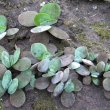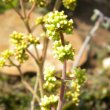Crassula decidua
| Botanical Name | Crassula decidua |
|||||||||||
| Family | Crassulaceae - The crassula family. |
|||||||||||
| Pronunciation | KRASS-oo-la dee-SID-yoo-uh |
|||||||||||
| Common Name(s) |
Afrikaans: Noorsveld Plakkie
|
|||||||||||
| Plant Group |
|
|||||||||||
| Plant Size |
|
|||||||||||
| Position |
|
|||||||||||
| General Information |
|
|||||||||||
| Specific Information | Crassula decidua is a very pretty little plant with grey-green leaves reaching around 6 cm tall (a bit bigger in cultivation), making it ideal for a small pocket in a rockery, a pretty pot or a miniature garden in a container. Unique to this crassula is that it is the only completely deciduous member of this family, (hence decidua), losing all its leaves after flowering. The specimens in the photos are stained from the soil in my garden and would look a lot better planted in clean sand. Crassula decidua is listed as 'Near Threatened' as two of its four confirmed subpopulations are from vegetation close to rivers, so are potentially threatened by agriculture. It is not common and difficult to find in nature. The common name, Noorsveld plakkie, comes from the area in which it lives called the Noorsveld. This is an area of the Karoo much populated by Euphorbia varieties, called 'Noors' in Afrikaans. "Plakkie", meaning slipper or sandal, is an Afrikaans name for almost any succulent with flat leaves. |
|||||||||||
| Ad Break | ||||||||||||
| Flowers | ||||||||||||
| Description | small tubular flowers on branches at the end of a long stem |
|||||||||||
| Season |
|
|||||||||||
| Colour |
|
|||||||||||
| Growth Rate |
|
|||||||||||
| Plant Uses |
|
|||||||||||
| Distribution and Habitat | in the Eastern Cape in the areas of Cookhouse, Somerset East and Cradock, in low karroid vegetation or in amongst succulent Euphorbia shrubs, close to rivers |
|||||||||||
| Planting Suggestions | Crassula decidua needs full sun for part of the day to flower but will tolerate a little filtered shade. It grows among or below scrubby shrubs and Euphorbia, so is shaded from the burning rays of the sun in its Karoo habitat. This is a summer growing crassula and needs less water during winter. Plant in well drained soil and water only when dry. Keep water to a minimum if you want the plant to flower. The dry habitat in which it grows receives around 250 mm of rain annually. The specimens in my garden have not flowered this year, perhaps because we have had too much rain for their liking (over 800 mm) during summer and autumn. So far (half way through July) they have not lost their leaves either, another sign that they have had too much moisture. |
|||||||||||
| Medicinal Uses | No data found. |
|||||||||||
| Ad Break | ||||||||||||








Discuss this plant
Share knowledge, ask a question or give an experience.